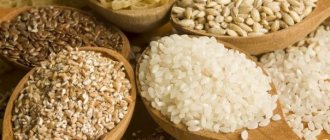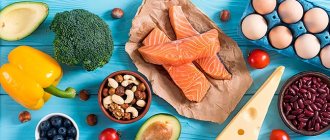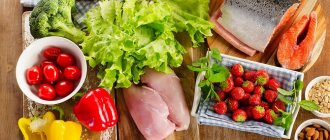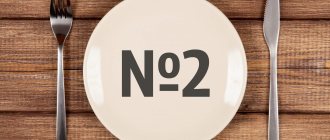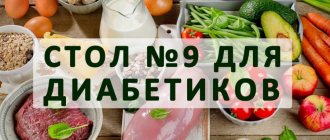In the twentieth century in Russia, gastroenterologist Professor Manuil Pevzner studied the influence of human diet to alleviate the course and treatment of various diseases. The result of many years of painstaking work was the creation of a series of therapeutic diets consisting of specially designed 15 tables. Each of the diets is intended for therapeutic nutrition of the patient depending on the disease and helps to quickly restore the body’s functioning.
The fifth diet is prescribed for liver diseases, impaired secretion of the digestive glands, and problems with the biliary tract. At different stages of diseases and complications, the composition of the diet may change. We’ll talk more about diet options No. 5, how to follow them, and the list of allowed and prohibited foods below.
Table number 5
The fifth table is a food system, which consists of a list of dishes, regime, and rules for processing food. Can be used in both adults and children. Its main goal is to improve and restore the functioning of the liver and biliary tract. In this regard, the indications for prescribing diet No. 5 are: chronic cholecystitis, liver cirrhosis (without decompensation), chronic hepatitis, liver steatosis. In addition, it is prescribed for 14-17 days after removal of the gallbladder. Also, table No. 5 can be used for mild toxicosis during pregnancy.
Diet 5 is applicable only in cases of chronic diseases outside of exacerbation and during periods of recovery. The use of this treatment table is contraindicated during periods of exacerbation of diseases and existing complications, as well as with concomitant gastritis or ulcers.
Content:
- Table number 5
- Therapeutic diet
- Menu for table No. 5
- Table number 5a
- Table number 5b
- Table number 5p
The diet is prescribed for a long time. At first it is prescribed for about a week with constant monitoring of the patient. If the nutritional system is tolerated normally, the course is extended. The duration of a therapeutic nutrition program is most often one and a half years and depends on the dynamics of the disease. Also, the prescribed diet No. 5 can be replaced or adjusted during this period.
A diet that includes table 5 is most often prescribed to patients with impaired liver and gallbladder function. Such nutrition improves the functions of these organs, and also normalizes metabolism and the digestion process. The program has a beneficial effect on almost all internal organs and can serve as a prevention of other diseases.
The main therapeutic effect on the liver, gall bladder and biliary tract is provided by three sparing factors. That is, the food taken should be gentle in chemical composition and mechanical processing. The temperature of the food you eat is also important.
Chemical composition. The main objective of diet No. 5 is to provide the patient with adequate nutrition, while excluding those foods that impair the functioning of the liver and gall bladder. For hepatitis, cirrhosis and cholecystitis, it is forbidden to eat foods high in cholesterol, fats, and essential oils. It is important to ensure that every day the patient consumes all the necessary components: proteins, carbohydrates, fats in small quantities. Salt is limited to 10 g per day. Table No. 5 is completely balanced and involves consuming 2500 kcal per day. For pregnant women, the daily calorie content should be at least 2800 kcal.
Diet No. 5 requires compliance with the temperature regime of the food consumed in the range from 20 to 60 degrees. Cold and too hot dishes are undesirable for diseases of the liver and bile ducts.
Mechanical processing is the grinding of food, which is necessary to facilitate the digestion process. For the fifth table, it is not necessary to chop or grind everything; a lot can be eaten in whole pieces. Vegetables with a high fiber content must be chopped: finely chopped, grated, boiled - grated through cheesecloth. The same goes for stringy meat.
Dietary dishes can be baked, boiled in milk or water, or steamed. Twice a week you can eat stew: vegetable stew, roast from minced meat, dietary cocotte. It is forbidden to eat fried foods, as such food contains fat oxidation products, which impede the production of bile, thereby impairing liver function. You need to eat often - at least 5 times a day, in medium portions.
Let's take a closer look at what the diet for a patient on the fifth diet may consist of.
Advice from nutritionists
It is impossible to cope with pancreatitis and other diseases of the thyroid gland or gallbladder with medications alone. Along with therapeutic measures, it is necessary to follow a diet. Taking into account all the recommendations of doctors, even the most advanced stages of the disease in adults go away within 1.5-2 years.
If any dish on the menu proposed by the nutritionist is negatively perceived by the body, you should immediately inform the doctor, who will adjust the diet taking into account the individual characteristics of the patient.
About the article
Name
Table 5 » Diet for pancreatitis and cholecystitis ✔️ Recipes
Announcement
Effective diet for pancreatitis ► Menu Table 5 ✅ List of products ✅ What you can do during an exacerbation ✅ Recipes ✅ Tables ✅ Menu for the week ✅ Advice from nutritionists
Author
Artem Anoshkin
Website
Investing in yourself
Publisher Logo
Therapeutic diet
The list of permitted products is quite wide.
Restrictions apply only to fatty, spicy, salty and fermented foods, because such food increases the secretion of digestive juices of the pancreas and irritates the gastric mucosa. Below is a list of foods that should be limited or completely eliminated. Table ration number 5
| Group | Allowed | Forbidden |
| First |
|
|
| Vegetables |
|
|
| Meat |
|
|
| Fish and seafood |
|
|
| Flour |
|
|
| Cereals |
|
|
| Milk products |
|
|
| Eggs |
|
|
| Berries and fruits |
|
|
| Dessert |
|
|
| Beverages |
|
|
Having a list of acceptable dishes and products, you can create therapeutic nutrition. It is recommended to prepare the menu in advance, at least 2 days in advance. This way you can stock up on the necessary products and select recipes, and preparing dishes will take less time. Exact adherence to all diet rules will protect against exacerbation of the disease and speed up recovery.
Menu for table No. 5
To make it easier to create your diet, you can consider a ready-made sample menu and recipes for it.
The first day
Breakfast: milk oatmeal with pureed dried fruits, tea.
Lunch: pureed low-fat cottage cheese, tea.
Lunch: beetroot soup, 10 g sour cream, buckwheat with meatballs, bread.
Dinner: baked zucchini pancakes, a little sour cream 10% fat.
Second day
Breakfast: semolina pudding, tea with milk.
Lunch: wheat bread toast, sour jam or jam, black tea.
Lunch: dietary cabbage soup, bread.
Dinner: buckwheat groats, berry compote.
Buckwheat: boil 200 g of buckwheat well in a large amount of water. Grate 200 g of cottage cheese, add to it a tablespoon of sugar, 100 ml of milk and one egg (mix everything). Combine the porridge and curd mass and bake under foil until fully cooked.
Day three
Breakfast: steamed carrot pancakes, tea.
Lunch: dry cookies, dried fruit compote.
Lunch: pearl barley soup, a little sour cream, bread.
Dinner: steamed chicken dumplings, boiled cauliflower.
Day four
Breakfast: semolina casserole, weak black tea.
Casserole: cook viscous semolina porridge and cool it (200 g of cereal). Add one and a half eggs, sugar, raisins or chopped prunes to the semolina. Beat everything well and bake in a greased pan until done.
Lunch: dry biscuit, fruit compote.
Lunch: soup with rice and vegetables, separately boiled chicken.
Dinner: boiled couscous with raisins, chamomile or rosehip infusion.
Day five
Breakfast: oatmeal with milk, tea.
Lunch: salad of cucumbers, lettuce and carrots.
Lunch: dietary borscht, sour cream, bread.
Dinner: vegetable stew, a piece of boiled lean beef.
Day six
Breakfast: baked pears with honey, tea.
Lunch: wheat toast with mashed cottage cheese.
Lunch: milk noodle soup.
Dinner: mashed potatoes, meatballs stewed in sour cream, rosehip broth.
Day seven
Breakfast: protein omelet with boiled green beans, tea.
Lunch: salad of dried apricots and grated carrots.
Lunch: soup with oatmeal, carrots and potatoes, bread.
Dinner: meat soufflé, rye bread toast, chamomile infusion.
Meat soufflé: mince 200 g of boiled beef twice and mix with 1 yolk. Pour 100 ml of milk into the minced meat and mix. Beat 2 egg whites into a thick foam and carefully mix them with the meat. Steam the soufflé.
Based on appetite, you can add snacks, second breakfast and afternoon snack. This is a sample menu for the week; you can make your own adjustments to it or come up with your own personal recipes. The main thing is not to deviate from the rules: eat only warm food from permitted ingredients in small portions.
Table number 5a
Diet 5a according to Pevzner is prescribed during periods of exacerbation of pancreatitis, cholecystitis, and cholelithiasis. It is used in cases of combination of these diseases with gastritis and peptic ulcer. The diet ensures maximum rest for the liver and gall bladder, spares the gastrointestinal tract, and facilitates the functioning of the bile ducts.
This diet option differs from the fifth table in even greater mechanical and chemical sparing. All dishes should be soft, pureed, slimy and mushy. The list of products remains the same, only with greater restrictions.
Soups should be light, with finely chopped or grated vegetables and pureed cereals. You can add boiled vermicelli and a little milk to them. Types with a high fiber content are excluded from fruits and vegetables; the consumption of quince and pear, as well as all varieties of cabbage, is not recommended.
Millet is prohibited from cereals. It is also not recommended to consume veal and young chickens. As for bakery products, it is preferable to eat no more than three pieces per day of dried bread made from second-grade flour. Desserts and drinks remain the same as in the previous version.
The menu for table 5a will consist of cereals, boiled vegetables, mashed potatoes (potatoes, meat) and vegetarian soups. You can prepare souffles, jelly, jellies, puddings, steamed cutlets and meatballs. It is important to eat the necessary proteins, fats and carbohydrates every day. It is forbidden to go hungry or eat too much.
Table 5a is prescribed until improvement occurs, then switches to another diet. It is strictly not recommended to independently adjust the diet during exacerbations of diseases.
Pros of diet for pancreatitis
The pancreas produces enzymes that are released into the duodenum and participate in the process of digesting food. With pancreatitis, due to such provoking factors as alcohol abuse, exacerbation of cholelithiasis, the outflow of pancreatic juice does not occur, and enzymes begin to act directly on the gland, i.e. the process of self-digestion begins.
The disease is characterized by acute pain in the area where the gland is located, accompanied by nausea and vomiting. Table No. 5 excludes difficult-to-digest foods to ease the work of the inflamed organ.
If the patient does not comply with the diet, salty and fatty foods irritate the gastric mucosa and increase the level of acidity, and since the gland does not work fully, food is poorly digested and takes a long time, and the patient’s well-being worsens.
Some patients suffer from a shortage of tasty, but harmful foods, which can not be completely excluded, you just have to learn how to prepare them correctly.
Table No. 5 allows people who are obese to lose weight. Patients who strictly adhere to the diet lose up to 5 kg per week.
Table number 5b
In the treatment of chronic pancreatitis against the background of drug therapy, diet No. 5b (or 5 p31) is used. This option is used in patients at the recovery stage after an attack of acute pancreatitis or in the remission phase after an exacerbation of chronic pancreatitis. The list of products remains the same as for table 5a. The food served should be warm and well chopped. The main restrictions concern fatty foods and sugar, which is replaced with sweeteners, preferably stevia.
The following are strictly prohibited: alcoholic and carbonated drinks, caffeine, sweets, flour (except for dried wheat bread), smoked foods, fried foods, pickles, raw fruits and vegetables. Low-fat dairy products are added to dishes; pureed cottage cheese is allowed (preferably calcined).
The diet consists of 6-7 meals, in small portions. The patient should eat a little food every 3-3.5 hours. Per day - approximately 1500 kcal. Everything is boiled, steamed or baked without crust while warm. Salt is limited (8 g per day).
The rest of the rules remain the same, as in previous versions of table No. 5. The main difference is more frequent meals and increased mechanical sparing. This option can be used for patients with concomitant chronic gastritis.
Reviews and results
This nutritional system has long been prescribed to patients with pathologies of the pancreas, so there are many reviews about it.
Svetlana, 39 years old, Krasnodar: “Last year I experienced an attack of pancreatitis for the first time. After 2 days of fasting, the doctor prescribed diet No. 5p. There were difficulties with the transition to such a diet. I had to learn how to cook healthy meals, but after starting the diet, my condition improved. There were no more attacks."
Igor, 47 years old, Irkutsk: “In my youth I abused alcohol, which led to the development of chronic pancreatitis. I ended up in the hospital, where the doctor prescribed medications and table No. 5p. I began to follow the specialist’s recommendations and switched to the recommended menu. The condition quickly stabilized."
